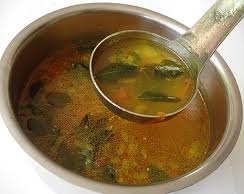Rasam (dish)


Rasam is a South Indian soup, traditionally prepared using tamarind juice as a base, with the addition of tomato, chili pepper, pepper, cumin and other spices as seasonings. Steamed lentils can be added along with any preferred vegetables. It is eaten with rice or alone, as a soup. In a traditional meal, it follows the sambar course and is followed by yogurt (curd) rice. Rasam has a distinct taste that combines sour, spicy, and, at times, sweet flavors.
History[edit]
The origin of rasam is rooted in the South Indian culinary tradition, with its history dating back centuries. It was originally called "rasa," which means "juice" or "essence" in Sanskrit. It evolved over time, incorporating various local ingredients and cooking techniques, reflecting the diversity of the South Indian region.
Ingredients[edit]
The basic ingredients of rasam include:
- Tamarind juice or tamarind paste, which provides the sour flavor.
- Tomatoes, which add a slight sweetness and tanginess.
- Black pepper and chili pepper, which contribute to its spiciness.
- Cumin, mustard seeds, and curry leaves, which are used for seasoning.
- Garlic and coriander, for aroma and flavor.
- Turmeric powder, for color and health benefits.
- Asafoetida, for digestion and additional flavor.
- Lentils (optional), usually toor dal, for thickness and protein.
Preparation[edit]
The preparation of rasam varies widely across different regions and households in South India. However, a common method involves boiling tamarind juice with tomatoes, adding the prepared spice mix (rasam powder), and then simmering with added water to achieve the desired consistency. Mustard seeds, cumin, curry leaves, and asafoetida are tempered in oil and added to the mixture. Cooked lentils may be included to make the dish heartier. Finally, fresh coriander leaves are sprinkled on top before serving.
Variations[edit]
There are numerous regional variations of rasam, including:
- Tomato Rasam, where tomato is the primary ingredient.
- Pepper Rasam (Milagu Rasam), made with black pepper and cumin, beneficial for colds and flu.
- Lemon Rasam, where lemon juice is used instead of tamarind.
- Pineapple Rasam, a sweeter version with chunks of pineapple.
- Garlic Rasam (Poondu Rasam), which uses a generous amount of garlic.
- Tamarind Rasam, focusing on a strong tamarind flavor.
Cultural Significance[edit]
Rasam is more than just a dish; it is a part of the South Indian way of life. It is commonly served in meals at home and is a staple in traditional feasts and weddings. Beyond its culinary importance, rasam is also valued for its medicinal properties, particularly its ability to aid digestion and its use as a home remedy for colds and flu.
Nutritional Value[edit]
Rasam is considered to be very beneficial for health. It is low in calories but rich in essential vitamins and minerals. The spices used in rasam, such as black pepper and cumin, have antioxidant properties and can help boost the immune system. The inclusion of lentils adds protein, making it a balanced dish.
See Also[edit]
Ad. Transform your life with W8MD's Budget GLP-1 injections from $75


W8MD offers a medical weight loss program to lose weight in Philadelphia. Our physician-supervised medical weight loss provides:
- Weight loss injections in NYC (generic and brand names):
- Zepbound / Mounjaro, Wegovy / Ozempic, Saxenda
- Most insurances accepted or discounted self-pay rates. We will obtain insurance prior authorizations if needed.
- Generic GLP1 weight loss injections from $75 for the starting dose.
- Also offer prescription weight loss medications including Phentermine, Qsymia, Diethylpropion, Contrave etc.
NYC weight loss doctor appointmentsNYC weight loss doctor appointments
Start your NYC weight loss journey today at our NYC medical weight loss and Philadelphia medical weight loss clinics.
- Call 718-946-5500 to lose weight in NYC or for medical weight loss in Philadelphia 215-676-2334.
- Tags:NYC medical weight loss, Philadelphia lose weight Zepbound NYC, Budget GLP1 weight loss injections, Wegovy Philadelphia, Wegovy NYC, Philadelphia medical weight loss, Brookly weight loss and Wegovy NYC
|
WikiMD's Wellness Encyclopedia |
| Let Food Be Thy Medicine Medicine Thy Food - Hippocrates |
Medical Disclaimer: WikiMD is not a substitute for professional medical advice. The information on WikiMD is provided as an information resource only, may be incorrect, outdated or misleading, and is not to be used or relied on for any diagnostic or treatment purposes. Please consult your health care provider before making any healthcare decisions or for guidance about a specific medical condition. WikiMD expressly disclaims responsibility, and shall have no liability, for any damages, loss, injury, or liability whatsoever suffered as a result of your reliance on the information contained in this site. By visiting this site you agree to the foregoing terms and conditions, which may from time to time be changed or supplemented by WikiMD. If you do not agree to the foregoing terms and conditions, you should not enter or use this site. See full disclaimer.
Credits:Most images are courtesy of Wikimedia commons, and templates, categories Wikipedia, licensed under CC BY SA or similar.
Translate this page: - East Asian
中文,
日本,
한국어,
South Asian
हिन्दी,
தமிழ்,
తెలుగు,
Urdu,
ಕನ್ನಡ,
Southeast Asian
Indonesian,
Vietnamese,
Thai,
မြန်မာဘာသာ,
বাংলা
European
español,
Deutsch,
français,
Greek,
português do Brasil,
polski,
română,
русский,
Nederlands,
norsk,
svenska,
suomi,
Italian
Middle Eastern & African
عربى,
Turkish,
Persian,
Hebrew,
Afrikaans,
isiZulu,
Kiswahili,
Other
Bulgarian,
Hungarian,
Czech,
Swedish,
മലയാളം,
मराठी,
ਪੰਜਾਬੀ,
ગુજરાતી,
Portuguese,
Ukrainian
